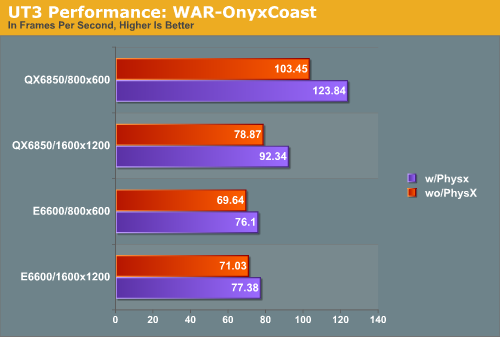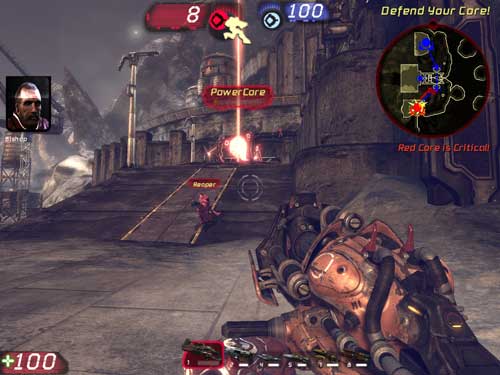PhysX’s Big Break? Unreal Tournament 3 PhysX Performance
by Ryan Smith on December 14, 2007 12:00 AM EST- Posted in
- GPUs
PhysX Performance Under UT3: Stock Maps
Moving on to performance with the stock UT3 maps, these do not involve any first-order physics to the best of our knowledge. However it’s still entirely possible to improve on second-order performance.

When we were originally benchmarking for this article, we started and intended to finish with WAR-OnyxCoast, an arctic-themed Warfare mode map that offers the full gamut of UT3 weapons and vehicles. What we found surprised us, so much in fact that we didn’t originally believe the results had we not been the ones doing benchmarking ourselves.
Against our initial expectations, WAR-OnyxCoast shows a performance improvement with the PhysX PPU installed, even with the light physics work being done. This is most obvious with our QX6850, where performance increases a respectable 15-20%. We ran this test several times more than the rest of our tests just to make sure this wasn’t a fluke or a product of botmatch variations and it’s not, there’s a definite performance improvement.
What’s driving this performance improvement we can only hypothesize on, compared to the more muted improvements with our E6600. Our best guess is that we’re CPU limited with the slower processor, with the limiting process being something other than physics (possibly bot AI), whereas that limit lifts with a faster processor. Of course we’d expect with more processing power the CPU would have no trouble keeping up with the PhysX PPU, but this doesn’t appear to be the case. It’s possible we’re still CPU and GPU limited on this map (explaining the change from 1600x1200 to 800x600), but we’re going to have to settle with the fact that we have a mystery on our hands for now.
Based on our results with WAR-OnyxCoast, we’ve also benchmarked CTF-Coret and WAR-Floodgate, to see if we can repeat those performance improvements, this time only with our QX6850.

Unlike WAR-OnyxCoast, neither of these maps showcases a large enough performance improvement with the PhysX hardware to positively confirm our earlier results. WAR-Floodgate is most like WAR-OnyxCoast out of these two additional maps, so it’s not particularly surprising that it peaks with an 8% performance improvement, but this is very close to the threshold for botmatch-induced variability, so it’s not conclusive. Meanwhile CTF-Coret flips between gaining and losing a marginal amount of performance, so we can be sure that it’s acting entirely within our experimental variability.
Looking at all of our results then, is the PhysX PPU improving performance under UT3’s stock maps? Probably. We can’t rule out other possibilities with the data we have, but our best explanation is that given a big enough map with enough players and vehicles, and enough of a computer to not be held down elsewhere, the PhysX PPU is giving us a measurable performance improvement of 10-20%. However we also have to keep in mind that with the frame rates we were already getting and the kinds of maps we believe this benefit is most pronounced on, that it’s not making a significant difference.











29 Comments
View All Comments
SignalPST - Friday, December 14, 2007 - link
On a unrelated note, does anyone know if the retail game shipped includes high resolution textures? People were complaining that the demo didn't include it, and the in-game graphics don't compare with anything like those eye-popping screenshots Epic teased us with.cubanx - Friday, December 14, 2007 - link
They are included but not the default. If you mess around with the settings you can get quality near the screen shots they released .Here's one tweak guide http://www.tweakguides.com/UT3_1.html">http://www.tweakguides.com/UT3_1.html
Dainas - Friday, December 14, 2007 - link
....And yet there still is NO PCIe PhysX card available for purchase.Heres another question for AGEIA; with dwindling PCI classic slots on todays motherboard, how do they expect people to use their products if there's no where to put it?
poohbear - Friday, December 14, 2007 - link
i hear u man. i have 1 soundcard and 1 wifi card and my other pci slot is blocked by the aftermarket cooler on my x1900xt, so there's simply no room for this card on pci even if i wanted to buy it.:pgoku - Monday, December 17, 2007 - link
get an ethernet to wifi converter, that way you can use the onboard ethernet on your motherboard.http://www.dslreports.com/shownews/Buffalo-Launche...">http://www.dslreports.com/shownews/Buff...Launches...
I'm sure there are others on the market as well.. I personally hate wifi and avoid it as much as possible. If I can get a wired connection, I'll use that first, even if it means running a line through the walls 50FT+ in order to get it.
SuperGee - Sunday, December 16, 2007 - link
That's choice there are more add-on's then ATX provide slot's for.This is not Ageia's problem. But more a choice the consumer must make.
Well I have a spare PCI slot next to my PPU. I realy don't have much in it a G-card and a PPU.
If for example choose for triple SLI you made a choice to blow away 3 to 9 slots.
Or must have a prof.RaidContoller and TV-card next to SLI. Then it get crowded with a soundcard..
And it not long ago that the populair sound card manufacturer offer a PCI-E sound card.
Mr Alpha - Friday, December 14, 2007 - link
I believe there is a PCIe x1 version of the PhysX card sold to OEMs. There was a story somewhere that said AGEIA was going to release the PhysX PCIe x1 card into retail, but decided not to when it turned out that it wouldn't work on a significant portion of the motherbaords with PCIe x1 slots, because the slots weren't implemented in accordance to PCIe specs. Something about out of spec jitter was mentioned.There is something Anandtech has been missing from their motherboard reviews: Do the PCIe x1 slots actually work?
PandaBear - Friday, December 14, 2007 - link
In Today's multi core CPU, unless you need to do physics with say 16 different threads, you would in theory ease 1 core out of all.Say the physics processor can do 1/2 of a CPU core's work (unlikely), then on a single core you gain 50% performance, dual core you gain 1/4, quad core 1/8.
Compare to how much of that work in theory could be done on a GPU (it's just math), and say it has the performance of 4 of the 48 shader's performance, you get 1/12 of a gain in GPU.
Now in practice, splitting work across a slow bus like PCIe, PCI, or HT are going to slow it down even more, with additional I/O work on both ends you are going to gain almost nothing (exactly where it is now).
I think if the market gets big enough, Nvidia or AMD will put one in their GPU, Intel/AMD will 1up each other by putting it in instead of wasting all the die space for cache. A dedicated physics processor on a bus as a card will never make it big.
Spoelie - Friday, December 14, 2007 - link
Your logic is completely flawed, since you do not know anything about the varying workloads, how good each type of chip is at each workload and how the workloads compare relatively.Specifically at physics calculation workloads, a PPU chip is a multitude of times faster than a cpu core. (Note the use of chip and core, since a ppu is more a collection of minicores). What this means is that when you peg one core of your multicore CPU at 100% load with solely physics threads, it is still way slower than a ppu, and thus can not handle the same physics workloads.
The actual performance boost is thus completely dependent on how big a workload the physics part of the application is. And current games do not have a big physics workload, partly because without a ppu the processing power is just not there.